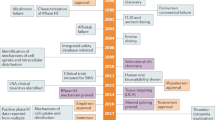Abstract
Synthetic Antisense oligonucleotides (ASOs) are novel and efficient laboratory tools to regulate the expression of specific genes, and have only recently come into clinical use. These are synthetic single-stranded DNA analogs, whose sequence is complementary to a target nucleotide and alter protein synthesis by several mechanisms. We herein provide a primer on the topic for pediatricians, as this group of drugs is likely to see many more drugs for previously incurable diseases.
Similar content being viewed by others
References
Chery J. RNA therapeutics: RNAi and antisense mechanisms and clinical applications. Postdoctoral Journal. 2016;4:35–50.
Verma A. Recent advances in antisense oligonucleotide therapy in genetic neuromuscular diseases. Ann Indian Acad Neurol. 2018;21:3–7.
Stephenson ML, Zamecnik PC. Inhibition of Rous sarcoma viral RNA translation by a specific oligo-deoxyribonucleotide. Proc Natl Acad Sci USA. 1978;75:285–8.
Shen X, Corey DR. Chemistry, mechanism and clinical status of antisense oligonucleotides and duplex RNAs. Nucleic Acids Res. 2018;46:1584–600.
Crooke ST, Wang S, Vickers TA, Shen W, Liang X. Cellular uptake and trafficking of antisense oligonucleotides. Nat Biotechnol. 2017;35:230–7.
Miller CM, Harris EN. Antisense oligonucleotides: Treatment strategies and cellular internalization. RNA Dis. 2016;3:4.
Dias N, Stein CA. Antisense oligonucleotides: Basic concepts and mechanisms. Mol Cancer Ther. 2002;1:347–55.
Gustincich S, Zucchelli S, Mallamaci A. The Yin and Yang of nucleic acid-based therapy in the brain. Prog Neurobio. 2017;155:194–211.
Chi X, Gatti P, Papoian T. Safety of antisense oligonucleotide and siRNA-based therapeutics. Drug Discov Today. 2017;22:823–33.
Prakash TP, Graham MJ, Yu J, Carty R, Low A, Chappell A, et al. Targeted delivery of antisense oligonucleotides to hepatocytes using triantennary N-acetyl galactosamine improves potency 10-fold in mice. Nucleic Acids Res. 2014;42:8796–807.
Geary RS. Antisense oligonucleotide pharmacokinetics and metabolism. Expert Opin Drug Metab Toxicol. 2009;5:381–91.
Braasch DA, Paroo Z, Constantinescu A, Ren G, Oz OK, Mason RP, et al. Biodistribution of phosphodiester and phosphorothioate siRNA. Bioorg Med Chem Lett. 2004;14:1139–43.
Bennett CF, Baker BF, Pham N, Swayze E, Geary RS. Pharmacology of antisense drugs. Annu Rev Pharmacol Toxicol. 2017;57:81–105.
Evers MM, Toonen LJA, van Roon-Mom WMC. Antisense oligonucleotides in therapy for neuro-degenerative disorders. Adv Drug Deliv Rev. 2015;87:90–103.
Wurster CD, Ludolph AC. Antisense oligonucleotides in neurological disorders. TherAdvNeurolDisord. 2018;11:1–19.
Stein CA, Castanotto D. FDA-approved oligonucleotide therapies in 2017. Mol Ther. 2017;25:1069–75.
Vitravene Study Group. A randomized controlled clinical trial of intra-vitreous fomivirsen for treatment of newly diagnosed peripheral cytomegalovirus retinitis in patients with AIDS. Am J Ophthalmol. 2002;133:467–74.
Gragoudas ES, Adamis AP, Cunningham ET Jr, Feinsod M, Guyer DR; VEGF Inhibition Study in Ocular Neovascularization Clinical Trial Group. Pegaptanib for neovascular age-related macular degeneration. N Engl J Med. 2004;351:2805–16.
Koo T, Wood MJ. Clinical trials using antisense oligonucleotides in Duchenne muscular dystrophy. Hum Gene Ther. 2013;24:479–88.
Mendell JR, Goemans N, Lowes LP, Alfano LN, Berry K, Shao J, et al. Longitudinal effect of eteplirsen versus historical control on ambulation in Duchenne muscular dystrophy: Eteplirsen in DMD. Ann Neurol. 2016;79:257–71.
Castro D, Iannaccone ST. Spinal muscular atrophy: therapeutic strategies. Curr Treat Options Neurol. 2014;16:316.
Spinraza [package insert]. Cambridge, MA: Biogen Inc;2017.
Finkel RS, Mercuri E, Darras BT, Connolly AM, Kuntz NL, Kirschner J, et al. Nusinersen versus sham control in infantile-onset spinal muscular atrophy. N Engl J Med. 2017;377:1723–32.
Mercuri E, Darras BT, Chiriboga CA, Day JW, Campbell C, Connolly AM, Lannaccone ST, et al; CHERISH Study Group. Nusinersen versus sham control in later-onset spinal muscular atrophy. N Engl J Med. 2018;378:625–35.
National Library of Medicine. 12 Studies found for: nusinersen. Available from: https://clinicaltrials.gov/ct2/results?cond=&term=nusinersen&cntry=&state=&city=&dist . Accessed March 17, 2018.
Hoy SM. Nusinersen: first global approval. Drugs. 2017;77:473–79.
McGowan MP, Tardif J-C, Ceska R, Burgess LJ, Soran H, Gouni-Berthold I, et al. Randomized, placebo-controlled trial of mipomersen in patients with severe hypercholesterolemia receiving maximally tolerated lipid-lowering therapy. PLoS One. 2012;7:e49006.
Thomas GS, Cromwell WC, Ali S, Chin W, Flaim JD, Davidson M. Mipomersen, an apolipoprotein B synthesis inhibitor, reduces atherogenic lipoproteins in patients with severe hypercholesterolemia at high cardiovascular risk. J Am Coll Cardiol. 2013;62:2178–84.
Richardson PG, Riches ML, Kernan NA, Brochstein JA, Mineishi S, Termuhlen AM, et al. Phase 3 trial of defibrotide for the treatment of severe veno-occlusive disease and multi-organ failure. Blood. 2016;127:1656–65.
Ackermann EJ, Guo S, Benson MD, Booten S, Freier S, Hughes SG, et al. Suppressing transthyretin production in mice, monkeys and humans using 2nd-generation antisense oligonucleotides. Amyloid. 2016;23:148–57.
Zimmerman TS, Karsten V, Chan A, Chiesa J, Boyce M, Bettencourt BR et al. Clinical proof of concept for a novel hepatocyte-targeting GalNAc-siRNA conjugate. Mol Ther. 2017;25:71–8.
Suhr OB, Coelho T, Buades J, Pouget J, Conceicao I, Berk J, et al. Efficacy and safety of Patisiran for familial amyloidotic polyneuropathy: A phase II multi-dose study. Orphanet J Rare Dis. 2015;10:109.
Winkler J, Stessl M, Amartey J, Noe CR. Off-target effects related to the phosphorothioate modification of nucleic acids. Chem Med Chem. 2010;5:1344–52.
Frazier KS. Antisense oligonucleotide therapies: the promise and the challenges from a toxicologic pathologist’s perspective. Toxicol Pathol. 2015;43:78–89.
KYNAMRO — Mipomersen sodium injection, solution. Official Label: http://www.accessdata.fda.gov/drugsatfda_docs/label/2016/203568s008lbl.pdf . Accessed 10 May, 2019.
Crooke ST, Baker BF, Kwoh TJ, Cheng W, Schulz DJ, Xia S, et al. Integrated safety assessment of 22 -o-methoxyethyl chimeric antisense oligonucleotides in nonhuman primates and healthy human volunteers. Mol Ther. 2016;24:1771–82.
Dalakas MC. Gene therapy for Duchenne muscular dystrophy: balancing good science, marginal efficacy, high emotions and excessive cost. Ther Adv Neurol Disord. 2017;10:293–6.
Gellad WF, Kesselheim AS. Accelerated approval and expensive drugs — A challenging combination. N Engl J Med. 2017;376:2001–04.
Editorial. Treating rare disorders: Time to act on unfair prices. Lancet Neurol. 2017;16:761.
Funding
None
Author information
Authors and Affiliations
Contributions
Both authors were involved in planning the manuscript and review of literature. Initial draft: AVK; Final manuscript: AVK, DM. Both authors approved the final manuscript.
Corresponding author
Additional information
Competing interest
None stated.
Rights and permissions
About this article
Cite this article
Krishnan, A.V., Mishra, D. Antisense Oligonucleotides: A Unique Treatment Approach. Indian Pediatr 57, 165–171 (2020). https://doi.org/10.1007/s13312-020-1736-7
Published:
Issue Date:
DOI: https://doi.org/10.1007/s13312-020-1736-7




